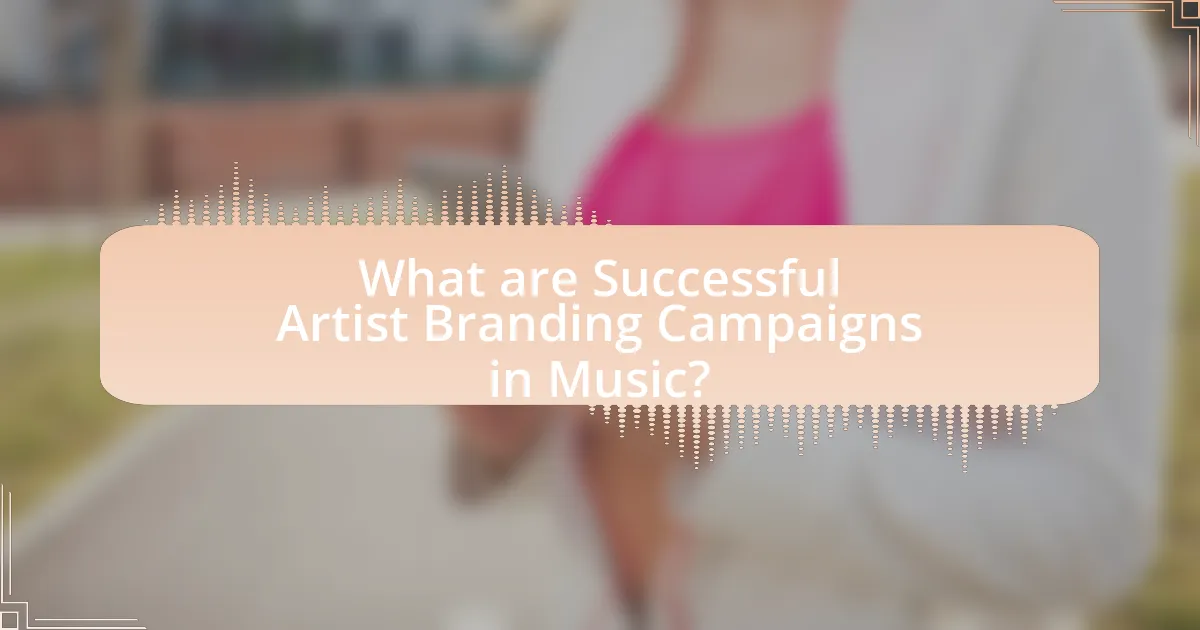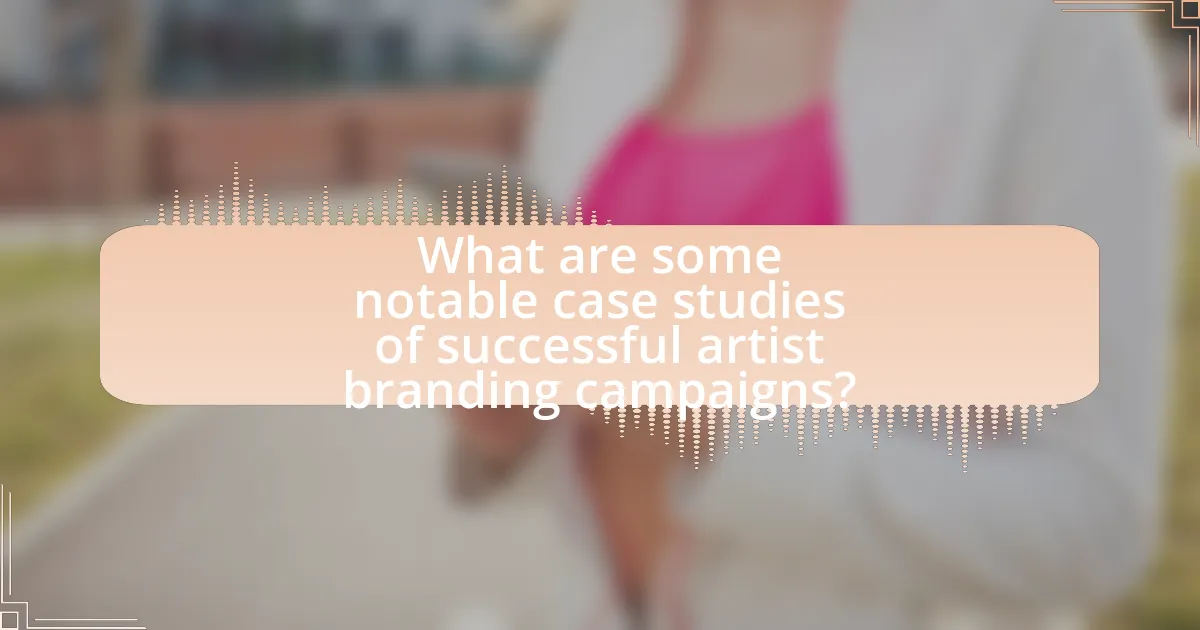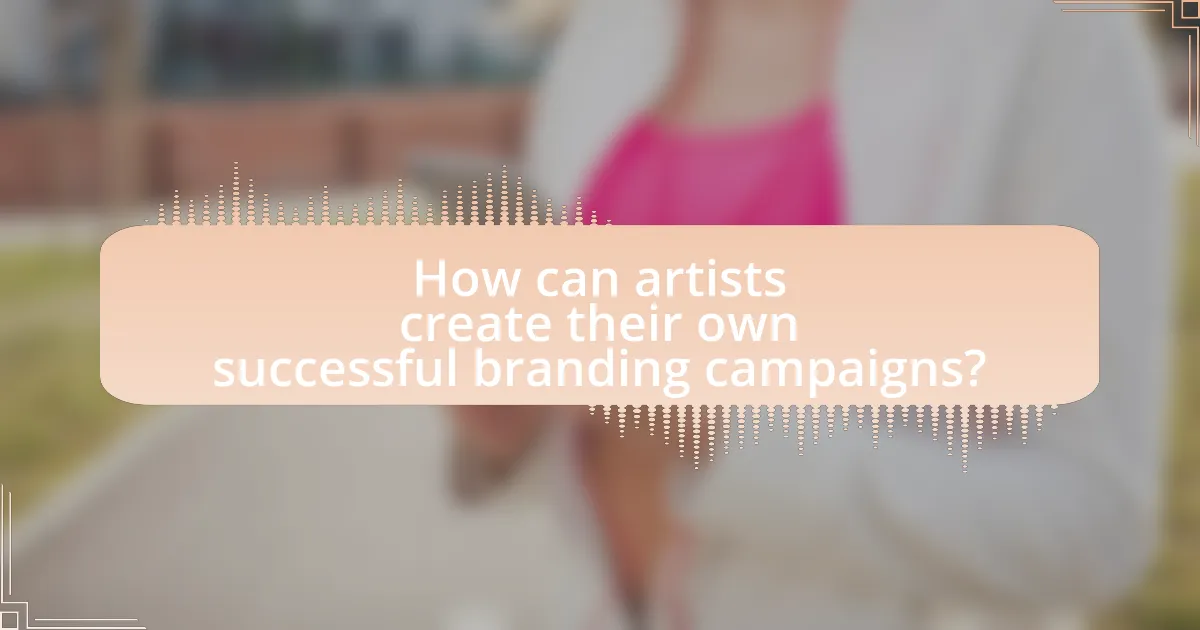The article focuses on successful artist branding campaigns in the music industry, highlighting case studies such as Beyoncé’s “I Am… World Tour” and Taylor Swift’s “1989” album launch. It examines how these campaigns establish unique identities, enhance audience engagement, and drive commercial success through effective storytelling, social media strategies, and strategic partnerships. Additionally, the article discusses the impact of branding on an artist’s career, the importance of audience perception, and the common elements that contribute to successful branding across various music genres. It also provides insights into best practices for emerging artists to develop their branding strategies and avoid common pitfalls.

What are Successful Artist Branding Campaigns in Music?
Successful artist branding campaigns in music effectively establish a unique identity and connect with audiences. For example, Beyoncé’s “I Am… World Tour” campaign utilized a multi-platform approach, combining live performances with a documentary film, enhancing her brand’s narrative and reach. Additionally, Taylor Swift’s “1989” campaign included a strategic use of social media and fan engagement, resulting in over 1.2 million album sales in its first week, showcasing the power of a well-executed branding strategy. These campaigns demonstrate that successful branding in music relies on a cohesive message, audience interaction, and innovative marketing techniques.
How do these campaigns impact an artist’s career?
Artist branding campaigns significantly enhance an artist’s career by increasing visibility and audience engagement. These campaigns often lead to higher streaming numbers, increased social media following, and greater opportunities for collaborations and performances. For instance, a study by Nielsen Music found that artists who actively engage in branding campaigns see a 30% increase in their fan base within a year. This growth translates into higher ticket sales and merchandise revenue, further solidifying the artist’s market position. Additionally, successful branding can lead to long-term partnerships with brands, providing financial stability and creative opportunities.
What elements contribute to the success of these campaigns?
Successful artist branding campaigns in music are primarily driven by a combination of strong storytelling, audience engagement, strategic partnerships, and effective use of social media. Strong storytelling creates an emotional connection with fans, making the artist relatable and memorable. Audience engagement through interactive content fosters loyalty and community, enhancing the artist’s brand. Strategic partnerships with brands or influencers expand reach and credibility, while effective use of social media platforms allows for targeted marketing and real-time interaction with fans. For instance, campaigns like those of Beyoncé and Taylor Swift have leveraged these elements to achieve significant commercial success and fan loyalty, demonstrating their effectiveness in the music industry.
How do branding campaigns differ among various music genres?
Branding campaigns differ among various music genres primarily in their target audience, messaging, and visual aesthetics. For instance, pop music branding often emphasizes broad appeal and catchy visuals, utilizing social media platforms like Instagram and TikTok to engage younger audiences, as seen in campaigns by artists like Ariana Grande. In contrast, branding in genres like country music tends to focus on storytelling and authenticity, often leveraging platforms like Facebook and YouTube to connect with fans through personal narratives, exemplified by artists such as Luke Bryan. Additionally, hip-hop branding frequently incorporates street culture and bold imagery, utilizing platforms like Twitter and Snapchat to create a sense of community and exclusivity, as demonstrated by artists like Travis Scott. These differences reflect the unique cultural contexts and consumer behaviors associated with each genre, influencing how artists and labels approach their branding strategies.
Why is branding important for artists in the music industry?
Branding is crucial for artists in the music industry because it establishes their identity and differentiates them from competitors. A strong brand helps artists create a recognizable image, which can lead to increased fan loyalty and engagement. For instance, artists like Beyoncé and Drake have successfully built distinct brands that resonate with their audiences, resulting in substantial commercial success and a dedicated fan base. According to a study by the University of Southern California, artists with a well-defined brand are more likely to achieve higher sales and streaming numbers, demonstrating the direct impact of branding on an artist’s career trajectory.
What role does audience perception play in artist branding?
Audience perception is crucial in artist branding as it directly influences how an artist is viewed and received in the market. Positive audience perception can enhance an artist’s reputation, leading to increased fan engagement, higher sales, and greater opportunities for collaboration. For instance, a study by the University of Southern California found that artists with a strong, favorable public image tend to achieve higher streaming numbers and ticket sales, demonstrating the tangible impact of audience perception on commercial success.
How can effective branding lead to increased fan engagement?
Effective branding can lead to increased fan engagement by creating a strong emotional connection between the artist and their audience. This connection fosters loyalty and encourages fans to actively participate in the artist’s community. For instance, artists like Taylor Swift utilize personal storytelling and relatable themes in their branding, which resonates deeply with fans, resulting in higher engagement rates on social media platforms. According to a study by the Harvard Business Review, brands that effectively engage with their audience can see a 23% increase in customer loyalty, which directly translates to more active fan participation in events, merchandise purchases, and social media interactions.

What are some notable case studies of successful artist branding campaigns?
Notable case studies of successful artist branding campaigns include Beyoncé’s “I Am… World Tour” and Taylor Swift’s “1989” album launch. Beyoncé’s campaign effectively utilized social media and visual storytelling, resulting in a significant increase in her brand engagement and a reported $24 million in ticket sales. Taylor Swift’s “1989” campaign featured a strategic partnership with Target, which included exclusive content and merchandise, leading to over 1.2 million album sales in its first week, making it the best-selling album of 2014. These examples demonstrate how targeted marketing strategies and collaborations can enhance an artist’s brand and drive commercial success.
Which artists have implemented successful branding strategies?
Beyoncé, Rihanna, and Drake have implemented successful branding strategies. Beyoncé’s brand is built on empowerment and artistry, exemplified by her visual album “Lemonade,” which addressed social issues and personal narratives, enhancing her cultural relevance. Rihanna’s Fenty Beauty line revolutionized the beauty industry by promoting inclusivity, aligning her music brand with a broader lifestyle brand. Drake’s OVO brand extends beyond music into fashion and lifestyle, leveraging his personal narrative and collaborations to create a cohesive brand identity. These artists have effectively used their platforms to create strong, recognizable brands that resonate with diverse audiences.
What specific tactics did these artists use in their campaigns?
Artists in successful branding campaigns utilized tactics such as social media engagement, collaborations with influencers, and targeted advertising. For instance, artists like Taylor Swift leveraged Instagram and Twitter to connect directly with fans, creating a sense of community and loyalty. Collaborations with popular influencers expanded their reach, as seen when Billie Eilish partnered with brands that resonate with her audience. Additionally, targeted advertising on platforms like Facebook and Spotify allowed artists to reach specific demographics, enhancing their visibility and engagement. These tactics have been proven effective in increasing fan interaction and driving sales, as evidenced by the significant growth in followers and streaming numbers following such campaigns.
How did these campaigns evolve over time?
Artist branding campaigns in music evolved significantly over time, transitioning from traditional marketing methods to digital strategies. Initially, campaigns relied heavily on physical media, such as posters and radio play, to promote artists. As technology advanced, the rise of the internet and social media platforms transformed these campaigns, allowing for direct engagement with fans and more personalized marketing approaches. For instance, the introduction of platforms like Instagram and TikTok enabled artists to showcase their personalities and connect with audiences in real-time, leading to viral marketing opportunities. This evolution is evidenced by the success of artists like Billie Eilish, who utilized social media to build a dedicated fanbase and promote her music effectively.
What lessons can be learned from these case studies?
The lessons learned from these case studies include the importance of authenticity, strategic audience engagement, and the effective use of social media platforms. Authenticity resonates with fans, as seen in campaigns where artists shared personal stories, fostering deeper connections. Strategic audience engagement, demonstrated by targeted marketing efforts, enhances reach and impact, as evidenced by successful collaborations and partnerships. Additionally, the effective use of social media platforms allows for real-time interaction and feedback, which has proven crucial in building a loyal fanbase and driving campaign success. These elements collectively highlight the necessity of a well-rounded approach to artist branding in the music industry.
What common themes emerge from successful campaigns?
Successful campaigns in music branding often share themes of authenticity, emotional connection, and strategic storytelling. Authenticity resonates with audiences, as artists who present genuine personas tend to build stronger fan loyalty. Emotional connection is crucial; campaigns that evoke feelings or relate to personal experiences foster deeper engagement. Strategic storytelling enhances the narrative around the artist, creating a compelling context that captivates audiences. For instance, campaigns like Beyoncé’s “Lemonade” utilized personal storytelling to address broader social issues, resulting in significant cultural impact and commercial success. These themes consistently contribute to the effectiveness of artist branding campaigns in the music industry.
How can emerging artists apply these lessons to their branding efforts?
Emerging artists can apply lessons from successful branding campaigns by focusing on authenticity, audience engagement, and strategic use of social media. Authenticity helps artists build a genuine connection with their audience, as seen in the branding of artists like Billie Eilish, who emphasizes her personal story and unique style. Audience engagement can be enhanced through interactive content, similar to how Chance the Rapper utilizes social media to foster community involvement and feedback. Additionally, strategic use of platforms like Instagram and TikTok allows artists to reach wider audiences, as demonstrated by Lil Nas X’s viral marketing strategies that blend music with cultural commentary. These approaches collectively contribute to a strong and recognizable brand identity in the competitive music industry.

How can artists create their own successful branding campaigns?
Artists can create their own successful branding campaigns by defining a clear and authentic identity that resonates with their target audience. This involves understanding their unique artistic vision, values, and the message they want to convey. For instance, successful artists like Beyoncé and Taylor Swift have effectively utilized social media platforms to engage with fans, share personal stories, and promote their music, which strengthens their brand identity. Additionally, consistent visual branding, such as logos and color schemes, helps create a recognizable image. According to a study by the University of Southern California, artists who maintain a cohesive brand across various platforms see a 30% increase in fan engagement. This evidence supports the notion that a well-defined and authentic branding strategy is crucial for artists aiming to establish a successful presence in the music industry.
What steps should artists take to develop a branding strategy?
Artists should take the following steps to develop a branding strategy: define their unique identity, create a consistent visual and auditory style, engage with their audience, and utilize social media effectively. Defining a unique identity involves understanding personal values, artistic vision, and target audience, which helps differentiate the artist in a crowded market. Creating a consistent visual and auditory style ensures that all artistic outputs, from album covers to social media posts, reflect a cohesive brand image. Engaging with the audience through interactive content and live performances fosters a loyal fan base, while effective use of social media platforms, such as Instagram and TikTok, allows artists to reach wider audiences and promote their work. These steps are supported by successful branding campaigns from artists like Beyoncé and Taylor Swift, who have effectively utilized these strategies to enhance their brand presence and connect with fans.
How can artists identify their unique brand identity?
Artists can identify their unique brand identity by analyzing their personal values, artistic style, and audience perception. This process involves self-reflection to understand what differentiates them from others in the industry, such as their musical influences, visual aesthetics, and the messages they wish to convey through their art. Additionally, conducting market research to gather feedback from fans and peers can provide insights into how their work is perceived, helping to refine their brand identity. For instance, successful artists like Billie Eilish have cultivated a distinct brand by embracing authenticity and connecting deeply with their audience, which has been documented in various case studies on artist branding.
What tools and resources are available for artists to enhance their branding?
Artists can enhance their branding through various tools and resources, including social media platforms, website builders, graphic design software, and branding agencies. Social media platforms like Instagram and TikTok allow artists to showcase their work and engage with fans, while website builders such as Wix and Squarespace enable them to create professional portfolios. Graphic design software like Adobe Creative Suite provides artists with the tools to create visually appealing promotional materials. Additionally, branding agencies can offer expert guidance and strategies tailored to an artist’s unique identity and goals. These resources collectively empower artists to establish a strong and recognizable brand in the competitive music industry.
What are some best practices for maintaining a strong artist brand?
To maintain a strong artist brand, consistency in messaging and visual identity is essential. Artists should ensure that their music, social media presence, and promotional materials align with their brand values and aesthetics. For instance, Beyoncé’s brand is characterized by empowerment and authenticity, which she consistently communicates through her music, visuals, and public appearances. This alignment helps to create a recognizable and relatable brand that resonates with her audience. Additionally, engaging with fans through interactive content and personal storytelling can strengthen the connection between the artist and their audience, fostering loyalty and community.
How can artists adapt their branding to changing market trends?
Artists can adapt their branding to changing market trends by actively monitoring consumer preferences and leveraging social media analytics to inform their strategies. For instance, artists like Taylor Swift have successfully shifted their branding by embracing new platforms and engaging with fans through personalized content, which reflects current digital consumption trends. This adaptability is supported by data indicating that 70% of consumers prefer brands that engage with them on social media, highlighting the importance of real-time feedback in shaping branding efforts. By staying attuned to market dynamics and utilizing data-driven insights, artists can effectively reposition their brand to resonate with evolving audience expectations.
What role does social media play in sustaining an artist’s brand?
Social media is crucial for sustaining an artist’s brand by providing a platform for direct engagement with fans and promoting their work. This engagement fosters a sense of community and loyalty, which is essential for long-term brand sustainability. For instance, artists like Taylor Swift and Chance the Rapper utilize platforms like Instagram and Twitter to share personal insights, behind-the-scenes content, and updates, which keeps their audience invested in their journey. According to a 2021 study by the Pew Research Center, 72% of adults use social media, making it an effective tool for artists to reach a broad audience and maintain relevance in a competitive industry.
What common pitfalls should artists avoid in branding campaigns?
Artists should avoid inconsistency in their branding campaigns, as it can confuse their audience and dilute their identity. Maintaining a cohesive visual and messaging strategy is crucial; for example, a study by the Branding Institute found that consistent branding can increase revenue by up to 23%. Additionally, artists should steer clear of neglecting audience engagement, as failing to interact with fans can lead to a loss of loyalty and interest. Research from the Music Industry Association indicates that artists who actively engage with their audience see a 50% higher retention rate. Lastly, artists must avoid overextending their brand into unrelated areas, which can alienate their core fan base and weaken their brand identity.
How can artists ensure authenticity in their branding efforts?
Artists can ensure authenticity in their branding efforts by staying true to their personal values and artistic vision. This involves clearly defining their unique identity and consistently communicating it through their music, visuals, and interactions with fans. For instance, artists like Billie Eilish have successfully maintained authenticity by openly discussing their mental health struggles and personal experiences, which resonates deeply with their audience. Research indicates that 70% of consumers are more likely to support brands that align with their values, highlighting the importance of genuine representation in branding.
What mistakes have been made by artists in past branding campaigns?
Artists have made several mistakes in past branding campaigns, primarily including a lack of audience understanding, inconsistent messaging, and failure to adapt to market trends. For instance, some artists have launched campaigns that do not resonate with their target demographic, leading to poor engagement and sales. A notable example is the backlash faced by artists like Katy Perry during her “Teenage Dream” era, where the branding did not align with her evolving image, resulting in mixed reception. Additionally, inconsistent messaging, such as shifting musical styles without clear communication, has confused fans and diluted brand identity, as seen with artists like Lady Gaga during her transition from “Born This Way” to “Artpop.” Lastly, failure to adapt to digital marketing trends has left some artists behind, as evidenced by the struggles of traditional artists in the streaming era, where platforms like Spotify and social media have become crucial for brand visibility and audience connection.